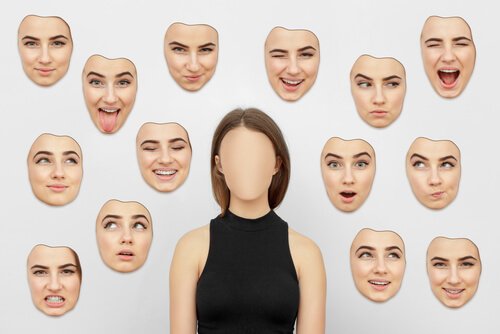Interpreting Other People's Emotions: A Matter of Confidence

Do you know how to interpret other people’s emotions? Every day, you see dozens or hundreds of facial expressions in other people. These expressions make you react in a certain way, depending on how you interpret them.
But do you interpret other people’s facial expressions correctly? To what extent do you trust your own judgment? Similarly, to what point does your confidence in emotional expression recognition depend on perceptual information or other non-perceptual information?
There’s no doubt that this allows us to avoid potentially dangerous situations. However, on many occasions, appearances can be deceiving.
A team from the University of Geneva studied how confident we are in our ability to interpret other people’s emotions. Additionally, they studied what brain areas activate in this process. Their results showed that our emotional interpretation stems directly from the experiences stored in our memory. However, these experiences sometimes confuse us. In other words, the past is not a perfect predictor of the future. The team published the results of the study in the journal Social, Cognitive and Affective Neuroscience in December 2018.
Interpreting other people’s emotions
You make dozens or hundreds of decisions every day. All of them imply a certain degree of trust in someone or something. However, said trust doesn’t always guarantee that the decision you made is correct. Sometimes you make bad decisions, even when you were totally sure that you had made the right ones. This happens in all aspects of life.
When it comes to social interactions, you’re constantly interpreting the facial expressions of those around you. In this sense, being aware of subjectivity is paramount when it comes to interpreting other people’s emotions.
With this in mind, researchers were interested in studying how confident we are in our interpretations of other people’s emotional behavior. Furthermore, they also wanted to discover which brain areas activate during these interpretations.
The scientists decided to measure confidence-related behavior. They asked 34 participants to interpret several faces that showed a mixture of positive and negative emotions. Each face was framed by two different horizontal bars. Some faces looked happy or angry, while others were more ambiguous.

The participants first had to define what emotions each of the 128 faces represented. Then, the participants had to choose which of the two bars was thickest. Finally, for each decision they made, they had to indicate their level of confidence in their choice. The scale ranged from 1 (not very sure) to 6 (very sure). The bars were used to assess their confidence in visual perception, which in this case serves as a control mechanism.
Shocking results
The results surprised the scientists. According to the researchers, the average emotional recognition confidence level was greater than the visual perception level. However, the participants made more emotional recognition mistakes.
They explained that learning emotional recognition is not as easy as learning perceptual judgment. The other person could lie, be insincere, or avoid expressing their facial emotions due to social conventions. Thus, it’s more difficult to correctly gauge our confidence in how we interpret other people’s emotions without any other comments that could clue us in.
Also, you have to interpret other people’s emotions very quickly since expressions are brief. Therefore, you may feel that your first impression is correct and you trust your judgment when it comes to interpreting an angry face. On the other hand, judging perception is a longer process.
Your memory influences your confidence
Using functional magnetic resonance imaging, researchers examined the neuronal mechanisms of this emotional recognition confidence process. They explained that when the participants judged the horizontal bars, the perception (visual areas) and attention areas (frontal areas) activated.
However, when assessing their confidence in emotional recognition, areas related to autobiographical and contextual memory, such as the parahippocampal gyrus and the cingulate gyrus, activated.

This shows that the brain systems that store personal and contextual memories are directly involved in emotional recognition. Furthermore, the researchers explained that they determine how accurately we interpret facial expressions and our confidence in this interpretation.
Do you know how to interpret other people’s emotions? Every day, you see dozens or hundreds of facial expressions in other people. These expressions make you react in a certain way, depending on how you interpret them.
But do you interpret other people’s facial expressions correctly? To what extent do you trust your own judgment? Similarly, to what point does your confidence in emotional expression recognition depend on perceptual information or other non-perceptual information?
There’s no doubt that this allows us to avoid potentially dangerous situations. However, on many occasions, appearances can be deceiving.
A team from the University of Geneva studied how confident we are in our ability to interpret other people’s emotions. Additionally, they studied what brain areas activate in this process. Their results showed that our emotional interpretation stems directly from the experiences stored in our memory. However, these experiences sometimes confuse us. In other words, the past is not a perfect predictor of the future. The team published the results of the study in the journal Social, Cognitive and Affective Neuroscience in December 2018.
Interpreting other people’s emotions
You make dozens or hundreds of decisions every day. All of them imply a certain degree of trust in someone or something. However, said trust doesn’t always guarantee that the decision you made is correct. Sometimes you make bad decisions, even when you were totally sure that you had made the right ones. This happens in all aspects of life.
When it comes to social interactions, you’re constantly interpreting the facial expressions of those around you. In this sense, being aware of subjectivity is paramount when it comes to interpreting other people’s emotions.
With this in mind, researchers were interested in studying how confident we are in our interpretations of other people’s emotional behavior. Furthermore, they also wanted to discover which brain areas activate during these interpretations.
The scientists decided to measure confidence-related behavior. They asked 34 participants to interpret several faces that showed a mixture of positive and negative emotions. Each face was framed by two different horizontal bars. Some faces looked happy or angry, while others were more ambiguous.

The participants first had to define what emotions each of the 128 faces represented. Then, the participants had to choose which of the two bars was thickest. Finally, for each decision they made, they had to indicate their level of confidence in their choice. The scale ranged from 1 (not very sure) to 6 (very sure). The bars were used to assess their confidence in visual perception, which in this case serves as a control mechanism.
Shocking results
The results surprised the scientists. According to the researchers, the average emotional recognition confidence level was greater than the visual perception level. However, the participants made more emotional recognition mistakes.
They explained that learning emotional recognition is not as easy as learning perceptual judgment. The other person could lie, be insincere, or avoid expressing their facial emotions due to social conventions. Thus, it’s more difficult to correctly gauge our confidence in how we interpret other people’s emotions without any other comments that could clue us in.
Also, you have to interpret other people’s emotions very quickly since expressions are brief. Therefore, you may feel that your first impression is correct and you trust your judgment when it comes to interpreting an angry face. On the other hand, judging perception is a longer process.
Your memory influences your confidence
Using functional magnetic resonance imaging, researchers examined the neuronal mechanisms of this emotional recognition confidence process. They explained that when the participants judged the horizontal bars, the perception (visual areas) and attention areas (frontal areas) activated.
However, when assessing their confidence in emotional recognition, areas related to autobiographical and contextual memory, such as the parahippocampal gyrus and the cingulate gyrus, activated.

This shows that the brain systems that store personal and contextual memories are directly involved in emotional recognition. Furthermore, the researchers explained that they determine how accurately we interpret facial expressions and our confidence in this interpretation.
All cited sources were thoroughly reviewed by our team to ensure their quality, reliability, currency, and validity. The bibliography of this article was considered reliable and of academic or scientific accuracy.
- Bègue, I., Vaessen, M., Hofmeister, J., Pereira, M., Schwartz, S., & Vuilleumier, P. (2018). Confidence of emotion expression recognition recruits brain regions outside the face perception network. Social Cognitive And Affective Neuroscience, 14(1), 81-95. doi: 10.1093/scan/nsy102
This text is provided for informational purposes only and does not replace consultation with a professional. If in doubt, consult your specialist.







